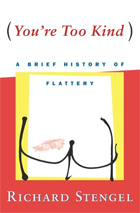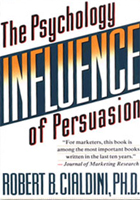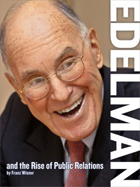Newcomers to PR, including students thinking of taking up PR or communications in college as well as experienced PR pros, can learn a lot from browsing in O'Dwyer's PR Library, a collection of 700+ books, periodicals, studies and databanks assembled over the past 45 years.
Especially recommended are ten books:
1. You're Too Kind; A Brief History of Flattery, by Richard Stengel
2. Influence: The Psychology of Persuasion, by Robert Cialdini
3. Celebrity Leverage, by Jordan McAuley
4. Edelman and the Rise of Public Relations, by Franz Wisner
5. Always Live Better than Your Clients, bio of Ben Sonnenberg by Isadore Barmash
6. The Tylenol Mafia by Scott Bartz, ex-Johnson & Johnson
7. The Power House, bio of Robert K. Gray, by Susan Trento
8. Deadly Spin by Wendell Potter, ex-Cigna
9. Army of Entrepreneurs by Jennifer Prosek
10. No Such Thing as Over-Exposure (for Donald Trump), by Robert Slater
Books Written by Knowledgeable Authors
The books have been written by those who know what they are talking about and who don't pull punches.
Wendell Potter, for instance, worked 20 years in PR at Cigna. Scott Bartz worked more than seven at J&J and has extensive knowledge of its distribution channels.
Stengel notes that flattery "thrives in hierarchical settings" such as companies and institutions.
Psychological ploys are rampant in PR and selling and are well catalogued by Cialdini in Influence.
 You're Too Kind says there is an "epidemic" of flattery in business and private circles and that those who don't practice some of its techniques can be left in the dust. He urges "smiling a lot" at superiors and others you want to impress because smiling means "I like you." Dressing extra special for someone, listening intently, using their name a lot, and spending time with them are also techniques.
You're Too Kind says there is an "epidemic" of flattery in business and private circles and that those who don't practice some of its techniques can be left in the dust. He urges "smiling a lot" at superiors and others you want to impress because smiling means "I like you." Dressing extra special for someone, listening intently, using their name a lot, and spending time with them are also techniques.
Influence describes numerous psychological tricks used on consumers. Residents of a California town were asked to sign a petition to "Keep California Beautiful." Next week they were asked to put a big sign on their lawns saying, "Drive Carefully." Half the signers agreed while almost no one else did.
The signers had unwittingly defined themselves as public-spirited and couldn't bear to be inconsistent. A clerk was told to mark down paste jewelry from $25.00 to $2.50. Instead he put the decimal in the wrong place (making them $250) and the entire case quickly sold out. People equated price with value. Toy makers heavily advertise a toy prior to Christmas but then run out. Parents must buy a substitute toy and later must also buy the original toy.

Celebrity Leverage is an excellent book on the celebrity mania gripping the country with plenty of good advice and tips for newcomers as well as veterans. More than 100 websites of use to PR people are provided. Denizens of this book are on good terms with reporters and wouldn't dream of ducking a call. They send written thank you notes to reporters whenever a client is mentioned. Their advice to those looking for a PR firm is to check what recent placements have been made by that firm for a similar product or service.
Edelman is a must-read book because it is a biography of the founder of what is now the world's largest PR firm, more than five times as big as the next independent. Daniel Edelman built his firm on commitments to ethics and transparency. He has reported his fee and employee totals, office-by-office, since 1970, and practice-by-practice, since 1992. Following the details of his life and those of other successful PR people builds knowledge of PR that cannot be captured in textbooks.
Sonnenberg became the single richest person in PR in the 1940s, 50s and 60s by serving clients' personal as well as business needs. He was a creative fountainhead, often showering clients with up to 100 ideas for improving their businesses. But he was also close to them personally, not hesitating to get up in the middle of the night and visit a client who called him. One client was worried that a son was going into show business. Sonnenberg correctly said the son would soon give it up. Doing favors for children of clients was a favorite activity of Sonnenberg.
The Tylenol Mafia is 719-pages of details about J&J and the 1982 Tylenol poisonings. No press conference was ever held and J&J only offered a $100,000 reward even though seven people died taking its product. It went right back on the market with easily-spiked capsules in "tamper-resistant" (hah!) bottles. Diane Elsroth, 23, became another Tylenol victim in 1986. Only then did J&J pull the capsules.
 The Power House provides a detailed look at how Robert Gray became a power broker in D.C., working closely with the President Reagan Administration. Gray took his firm public and later sold it to Hill and Knowlton, his former employer. Gray sued author Susan Trento but lost. Time did a major piece on Gray.
The Power House provides a detailed look at how Robert Gray became a power broker in D.C., working closely with the President Reagan Administration. Gray took his firm public and later sold it to Hill and Knowlton, his former employer. Gray sued author Susan Trento but lost. Time did a major piece on Gray.
Deadly Spin covers how PR is used by Cigna and other healthcare giants. It notes that many of the activities of the industry are cloaked in secrecy. Donors to non-profit trade groups, for instance, don't have to identify themselves in tax forms or elsewhere.
Army of Entrepreneurs by Jennifer Prosek, who heads a $15 million New York firm, tells how she has trained her employees to be on the lookout for potential new clients almost wherever they are. The book captures the "go-go" atmosphere of PR firms which is almost completely different from the defensive posture that is common at companies and institutions.
Trump biography is a must because The Donald is Exhibit A on how notoriety can bring riches. Trump described his slam-bang approach to business to the PR Society of America national conference in 2004. Never trust another businessperson and if one of them does you any harm be sure to respond with a double dose of harm to them, he advised. Students thinking of a PR career must know the tooth and claw nature of business competition.
PR Was Much Friendlier, Open
The hundreds of books on PR, publicity and marketing, bios and speeches of PR leaders, and O'Dwyer and other PR publications dating back to 1968 reveal a PR world that up until the early 1980s was much more open, friendlier, and less stressful than it is today.
Virtually every major company, ad agency and PR firm had a person dedicated to mingling with reporters, visiting them at their desks if lunches could not be arranged. Ad agency and PR firm presidents hosted reporters in their corporate dining rooms.
In New York, more than 20 PR groups flourished topped by the New York chapter of PRSA which each month held a lunch for nearly 300 practitioners in the Waldorf-Astoria.
Serial party-givers included Sonnenberg who regularly hosted up to 200 at his five-story townhouse in Gramercy Park, ITT's Ned Gerrity, who hosted an annual dinner for the press at the St. Regis and a picnic in Nutley, N.J., and PR News founder Denny Griswold, who hosted an annual dinner for 300 in the Pierre and countless private dinners.
The press-friendly culture of PRSA in the 1970s is indicated by its policy of inviting reporters (including this writer) to be Silver Anvil judges.
Twin Blights: Congloms & APR
 O'Dwyer's PR Library |
What happened to turn friendliness into open hostility and alienation?
Those who visit the O'Dwyer Library will find out.
The conglomerates of WPP Group, Omnicom, Interpubic and Publicis, after swallowing just about every ad agency, small or large, went to work on PR, capturing 19 of the 25 biggest firms in the O'Dwyer rankings.
The financiers who run the congloms much prefer to deal with Wall St. analysts, who rarely issue a "sell" order, rather than the press. That attitude spread quickly throughout their PR empires resulting in their PR firms going almost completely dark in 2001. Gone were their account lists, revenue totals and employee counts. Dedicated press contacts were eliminated. Omnicom took its annual meeting out of town rather than face reporters.
APR Blight Wrecked PRSA Culture
The open culture of the PR Society, typified by having a library open to all in midtown and inviting reporters as Silver Anvil judges, ended in 1980 when counselor Patrick Jackson became president. He instituted a policy of only having association career people at h.q. rather than PR people. About 10 such staffers were ditched. Only one PR person, Donna Peltier, worked at h.q. from 1984-94.
The association careerists bonded with supporters of accreditation, a process that started out with good intentions but ended up attracting just under 20% of the membership. Costs of the program ballooned ($2.9 million loss from 1986-2002).
Corners were cut. In place of a grueling exam that required 5.5 hours of writing came a multiple-choice test lasting 3.5 hours. No live writing at all is involved in the new process, instituted in 2003. The number of new Society APRs created in the past nine years is less than half of what it was in the previous ten. The APR-controlled Assembly since 1999 has rebuffed attempts to remove their monopoly on national offices and membership on the Ethics Board.
60+ "PR" books, 34 on Marketing/Publicity
O'Dwyer's PR Library includes more than 60 books with PR in the title; 24 with marketing in the title and ten with publicity in the title. More than 10 books each are in subject categories such as "ethics," "crisis PR," "financial/investor relations, and biographies. A list of nearly 200 of the books is here: http://tinyurl.com/d8f84hu.
There are extensive files, including tax and financial reports and membership lists for more than 15 PR and journalist organizations such as PRSA and its Foundation, Institute for PR, IABC, National Investor Relations Institute, Council of PR Firms, Arthur W. Page Society, (PR) Seminar, New York Financial Writers Assn., Society of Professional Journalists, ProPublica, Assn. for Education in Journalism and Mass Communication, Poynter Institute, Committee to Protect Journalists, Pew Research Project for Excellence in Journalism, National Press Club and Overseas Press Club.
Also available to users are O'Dwyer Newsletters from July 10, 1968 O'Dwyer magazines from August 1987; PR Week/U.S. from 1998; Contact Directories of PRW/U.S. from 2000; past directories of PRSA, IABC, NIRI and Page Society (such directories are no longer in print); back issues of Tactics and Strategist of PRSA and Communication World of IABC.
Five Major PR Textbooks Available
Current and past editions of the five major college PR textbooks are available: Practice of PR, PR: Strategies & Tactics, Effective PR, This is PR: The Realities of PR, and PR: The Profession and the Practice.
Biographies of PR leaders such as Dan Edelman, Robert Wood and Ben Sonnenberg are available.
The library, which is equipped with Wi-Fi, is open at no charge to anyone for the first visit. After that, there must be at least one $295 subscription at the person's employer. Some books will be available for loaning if security is provided.


 Celebrity Leverage, by West Hollywood publicist Jordan McAuley, is a fabulous guide to linking products and personalities to celebrities of all types to capitalize on the celebrity mania that is gripping the country.
Celebrity Leverage, by West Hollywood publicist Jordan McAuley, is a fabulous guide to linking products and personalities to celebrities of all types to capitalize on the celebrity mania that is gripping the country.


 Have a comment? Send it to
Have a comment? Send it to 
No comments have been submitted for this story yet.